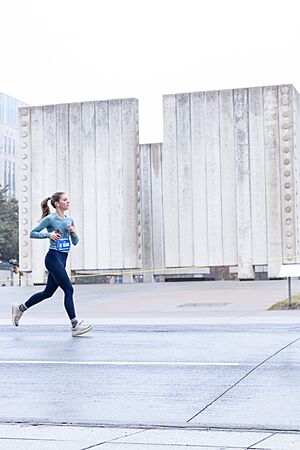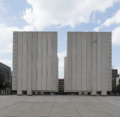John Fitzgerald Kennedy Memorial facts for kids

John Fitzgerald Kennedy Memorial in Dallas (2024)
|
|
| Coordinates | 32°46′43″N 96°48′23″W / 32.77861°N 96.80639°W |
|---|---|
| Location | Dallas, Texas |
| Designer | Philip Johnson |
| Type | Cenotaph |
| Material | Concrete and granite |
| Length | 50 ft (15 m) |
| Width | 50 ft (15 m) |
| Height | 30 ft (9.1 m) |
| Beginning date | 1969 |
| Opening date | June 24, 1970 |
| Restored date | 2000 |
| Dedicated to | John F. Kennedy |
|
Kennedy Memorial and Plaza
|
|
|
U.S. Historic district
Contributing property |
|
|
U.S. National Historic Landmark District
Contributing Property |
|
| Part of |
|
| Significant dates | |
| Designated CP | November 14, 1978 |
| Designated NHLDCP | October 12, 1993 |
The John Fitzgerald Kennedy Memorial is a special monument in downtown Dallas, Texas. It honors John F. Kennedy, who was the 35th President of the United States. This memorial was built in 1970 and was designed by a famous architect named Philip Johnson. It is located in the West End Historic District.
Contents
Designing the Kennedy Memorial
The John F. Kennedy Memorial was the first memorial designed by the famous American architect Philip Johnson. He was a friend of the Kennedy family. Jacqueline Kennedy, President Kennedy's wife, approved his design.
Johnson wanted the memorial to be "a place of quiet refuge." He imagined it as a peaceful spot for thinking, separate from the busy city. People in Dallas raised $200,000 for the memorial by August 1964. This money came from 50,000 donations by everyday citizens.
The Memorial Plaza
The memorial is located in a city block in downtown Dallas. This block is also known as the John Fitzgerald Kennedy Memorial Plaza. It is about 200 yards (183 meters) east of Dealey Plaza. This is the place where President Kennedy died. Dallas County owns the plaza.
What is a Cenotaph?
Philip Johnson's design is called a cenotaph. A cenotaph is like an empty tomb or monument. It honors someone whose body is buried somewhere else. This design symbolizes the freedom of Kennedy's spirit.
The memorial is a square room without a roof. It is 30 feet (9 meters) tall and 50 by 50 feet (15 by 15 meters) wide. It has two narrow openings, one facing north and one facing south.
Building the Cenotaph
The walls of the memorial are made of 72 white concrete columns. Most of these columns stop about 29 inches (74 cm) above the ground. Eight columns, two in each corner, reach all the way to the ground. These act like legs that support the structure.
Each column has a light fixture at its top. At night, these lights make it look like the whole building is floating on light. The corners and openings of this roofless room have rows of concrete circles. These circles are all the same and perfectly lined up. They add a round shape to the square design of the memorial.
Inside the Memorial
The cenotaph sits on a low concrete hill. This hill has squares carved into it and is slightly higher than the street. Inside the memorial, there is a dark granite block. It is 8 feet (2.4 meters) square and sits in a shallow dip.
The name "John Fitzgerald Kennedy" is carved in gold letters on the north and south sides of this granite block. The gold letters catch the light from the white walls and pale floor. These three words are the only words inside the quiet, empty room.
The Epitaph Markers
Two dark granite squares are placed in the plaza around the memorial. Each is about 50 feet (15 meters) from the narrow entrances to the cenotaph. An epitaph is carved into each of these squares. An epitaph is a short text written in memory of a dead person.
The epitaph says that John F. Kennedy's life brought joy and excitement to everyone. It also says that his death brought pain and sorrow to the world. It mentions that he died in Dallas on November 22, 1963. The memorial was built by the people of Dallas, with thousands of citizens helping. It is a tribute to the joy of his life, not the sadness of his death.
History of the Memorial
The idea for a monument to President Kennedy came up just two days after he died. Dallas County Judge Lew Sterrett suggested it on November 24, 1963. On December 2, a committee was formed to make it happen.
Many people in Dallas wanted a memorial. But some thought it should be in Washington D.C. They wanted to distance Dallas from the sad event. The committee asked for design ideas. They received 260 proposals in just one week! By February 1964, they had received 700 ideas.
Choosing the Design and Location
On February 22, 1964, the committee decided to create two memorials. One would be at the John F. Kennedy Library in Boston. The other would be a "dignified and modest memorial" near where he died.
The location near the Old Red Courthouse was chosen in April 1964. The architect, Philip Johnson, agreed to design the memorial for free. His design was shown to the committee in December 1964.
Construction and Dedication
The committee hoped to have the memorial ready by November 1968. However, an underground parking garage was built first. Construction on the memorial itself did not start until 1969.
The memorial was finally dedicated on June 24, 1970. About 300 people attended the ceremony. Sargent Shriver, a member of the Kennedy family, visited the memorial in 1972.
Caring for the Memorial
In 1999, the memorial was damaged by graffiti. Later that year, The Sixth Floor Museum at Dealey Plaza took over managing the memorial. They worked with Dallas County and the City of Dallas to restore it.
Philip Johnson, the original architect, helped guide the restoration. Many local companies donated their time and materials to make the memorial beautiful again. In 2000, experts wrote an explanation of the memorial for the public.
Today, about 500,000 people visit the John F. Kennedy Memorial every year.
See also
 In Spanish: Monumento conmemorativo de John Fitzgerald Kennedy para niños
In Spanish: Monumento conmemorativo de John Fitzgerald Kennedy para niños
- Four Freedoms Park, designed by Louis Kahn and compared to Johnson's Kennedy Memorial by The New York Times
- List of memorials to John F. Kennedy
- List of National Historic Landmarks in Texas
- National Register of Historic Places listings in Dallas County, Texas
- List of Dallas Landmarks
- Presidential memorials in the United States
Images for kids








